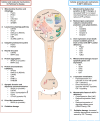Is insulin-like growth factor-1 involved in Parkinson's disease development?
- PMID: 32046737
- PMCID: PMC7014772
- DOI: 10.1186/s12967-020-02223-0
Is insulin-like growth factor-1 involved in Parkinson's disease development?
Abstract
Parkinson's disease (PD) is a neurodegenerative disorder that results in the death of dopaminergic neurons within the substantia nigra pars compacta and the reduction in dopaminergic control over striatal output neurons, leading to a movement disorder most commonly characterized by akinesia or bradykinesia, rigidity and tremor. Also, PD is less frequently depicted by sensory symptoms (pain and tingling), hyposmia, sleep alterations, depression and anxiety, and abnormal executive and working memory related functions. On the other hand, insulin-like growth factor 1 (IGF-1) is an endocrine, paracrine and autocrine hormone with several functions including tissue growth and development, insulin-like activity, proliferation, pro-survival, anti-aging, antioxidant and neuroprotection, among others. Herein this review tries to summarize all experimental and clinical data to understand the pathophysiology and development of PD, as well as its clear association with IGF-1, supported by several lines of evidence: (1) IGF-1 decreases with age, while aging is the major risk for PD establishment and development; (2) numerous basic and translational data have appointed direct protective and homeostasis IGF-1 roles in all brain cells; (3) estrogens seem to confer women strong protection to PD via IGF-1; and (4) clinical correlations in PD cohorts have confirmed elevated IGF-1 levels at the onset of the disease, suggesting an ongoing compensatory or "fight-to-injury" mechanism.
Keywords: Aging; Central nervous system; Dopamine; Estrogens; IGF-1; Parkinson’s disease.
Conflict of interest statement
The authors declare that they have no competing interests.
Figures



Similar articles
-
Therapeutic potentials of plant iridoids in Alzheimer's and Parkinson's diseases: A review.Eur J Med Chem. 2019 May 1;169:185-199. doi: 10.1016/j.ejmech.2019.03.009. Epub 2019 Mar 8. Eur J Med Chem. 2019. PMID: 30877973 Review.
-
Multifactorial sleep disturbance in Parkinson's disease.Sleep Med. 2017 Jul;35:41-48. doi: 10.1016/j.sleep.2017.03.026. Epub 2017 Apr 25. Sleep Med. 2017. PMID: 28619181 Review.
-
Subthalamic GAD gene transfer in Parkinson disease patients who are candidates for deep brain stimulation.Hum Gene Ther. 2001 Aug 10;12(12):1589-91. Hum Gene Ther. 2001. PMID: 11529246 Clinical Trial.
-
Disease modification in Parkinson's disease.Drugs Aging. 2011 Aug 1;28(8):605-15. doi: 10.2165/11591320-000000000-00000. Drugs Aging. 2011. PMID: 21812497 Review.
-
Post mortem studies in Parkinson's disease--is it possible to detect brain areas for specific symptoms?J Neural Transm Suppl. 1999;56:1-29. doi: 10.1007/978-3-7091-6360-3_1. J Neural Transm Suppl. 1999. PMID: 10370901 Review.
Cited by
-
Growth Factors and Their Application in the Therapy of Hereditary Neurodegenerative Diseases.Biomedicines. 2024 Aug 20;12(8):1906. doi: 10.3390/biomedicines12081906. Biomedicines. 2024. PMID: 39200370 Free PMC article. Review.
-
The Intestine as a Lifespan- and Proteostasis-Promoting Signaling Tissue.Front Aging. 2022 Jun 2;3:897741. doi: 10.3389/fragi.2022.897741. eCollection 2022. Front Aging. 2022. PMID: 35821863 Free PMC article. Review.
-
Physiological and Pathological Functions of Neuronal Hemoglobin: A Key Underappreciated Protein in Parkinson's Disease.Int J Mol Sci. 2022 Aug 13;23(16):9088. doi: 10.3390/ijms23169088. Int J Mol Sci. 2022. PMID: 36012351 Free PMC article. Review.
-
From Menopause to Neurodegeneration-Molecular Basis and Potential Therapy.Int J Mol Sci. 2021 Aug 11;22(16):8654. doi: 10.3390/ijms22168654. Int J Mol Sci. 2021. PMID: 34445359 Free PMC article. Review.
-
Role of the Insulin-like Growth Factor System in Neurodegenerative Disease.Int J Mol Sci. 2024 Apr 20;25(8):4512. doi: 10.3390/ijms25084512. Int J Mol Sci. 2024. PMID: 38674097 Free PMC article. Review.
References
Publication types
MeSH terms
Substances
LinkOut - more resources
Full Text Sources
Medical
Miscellaneous

